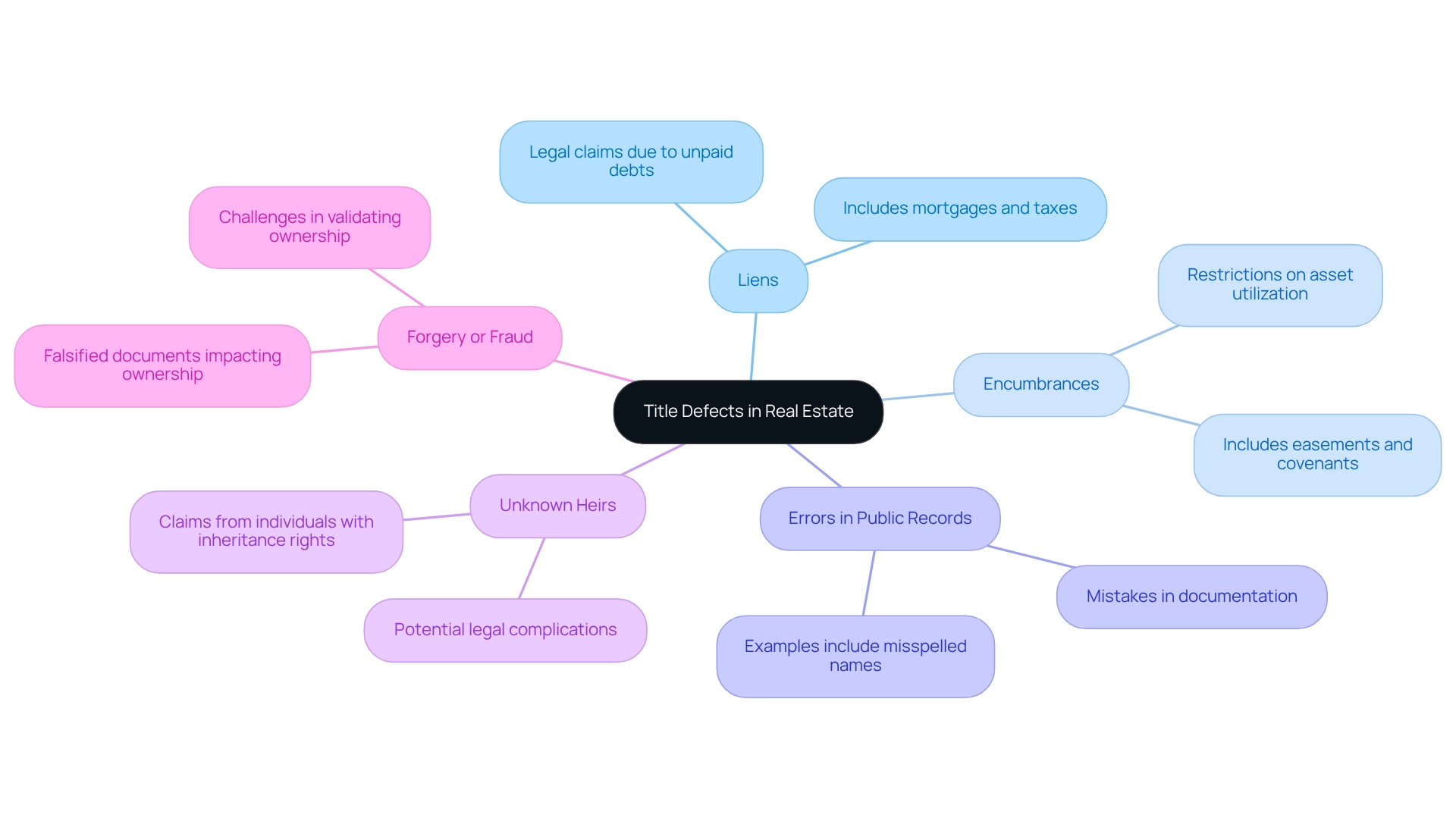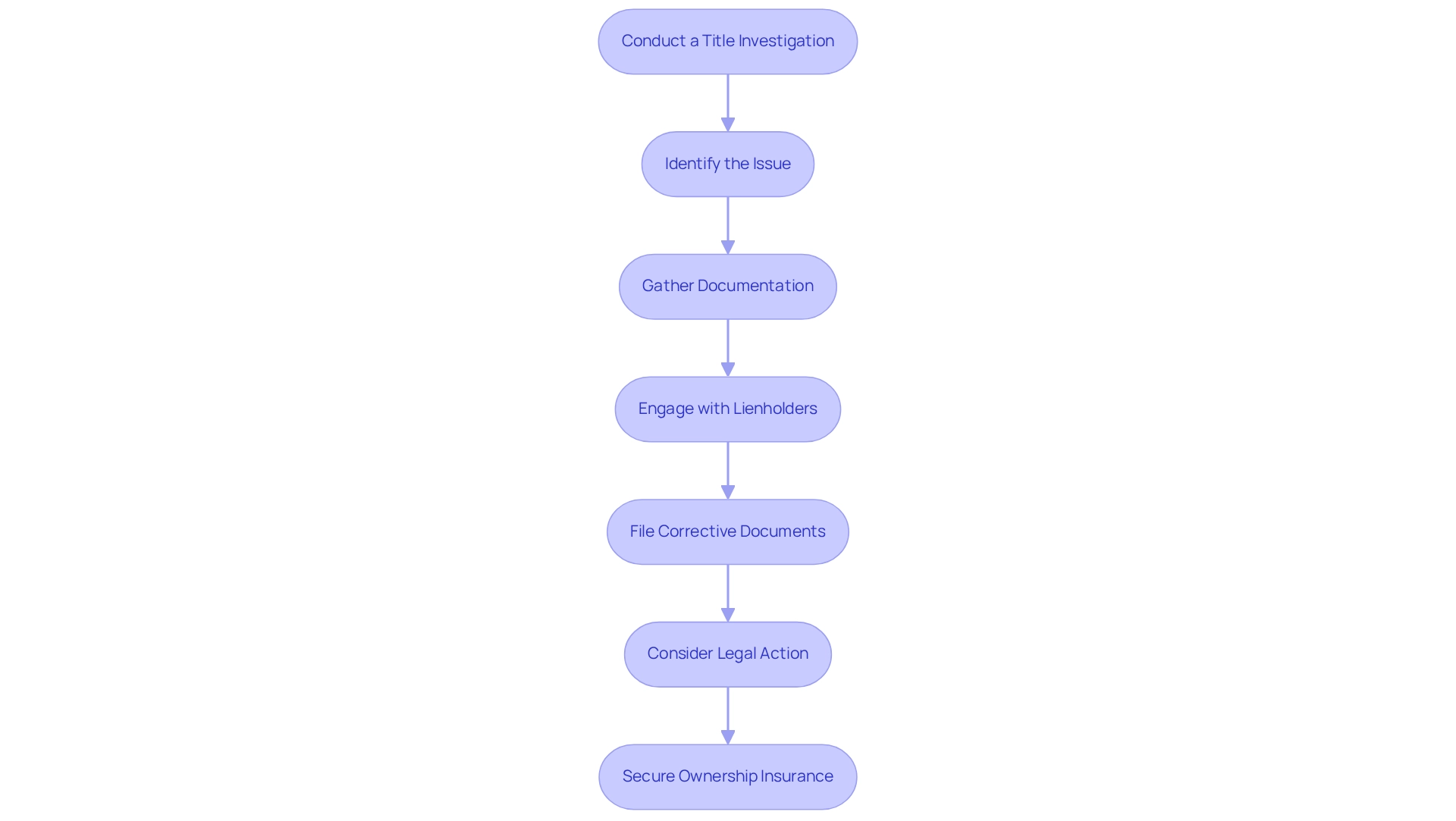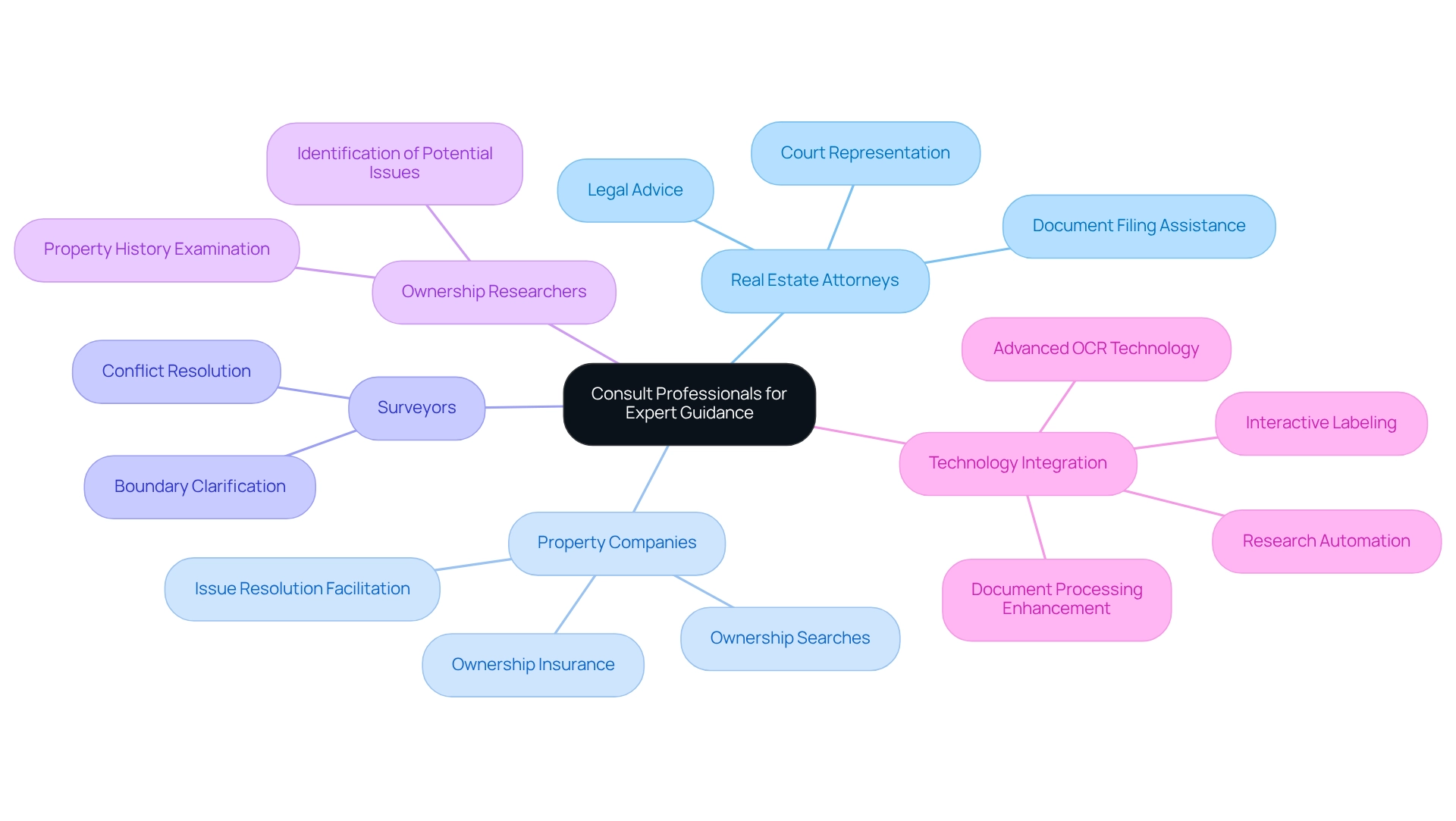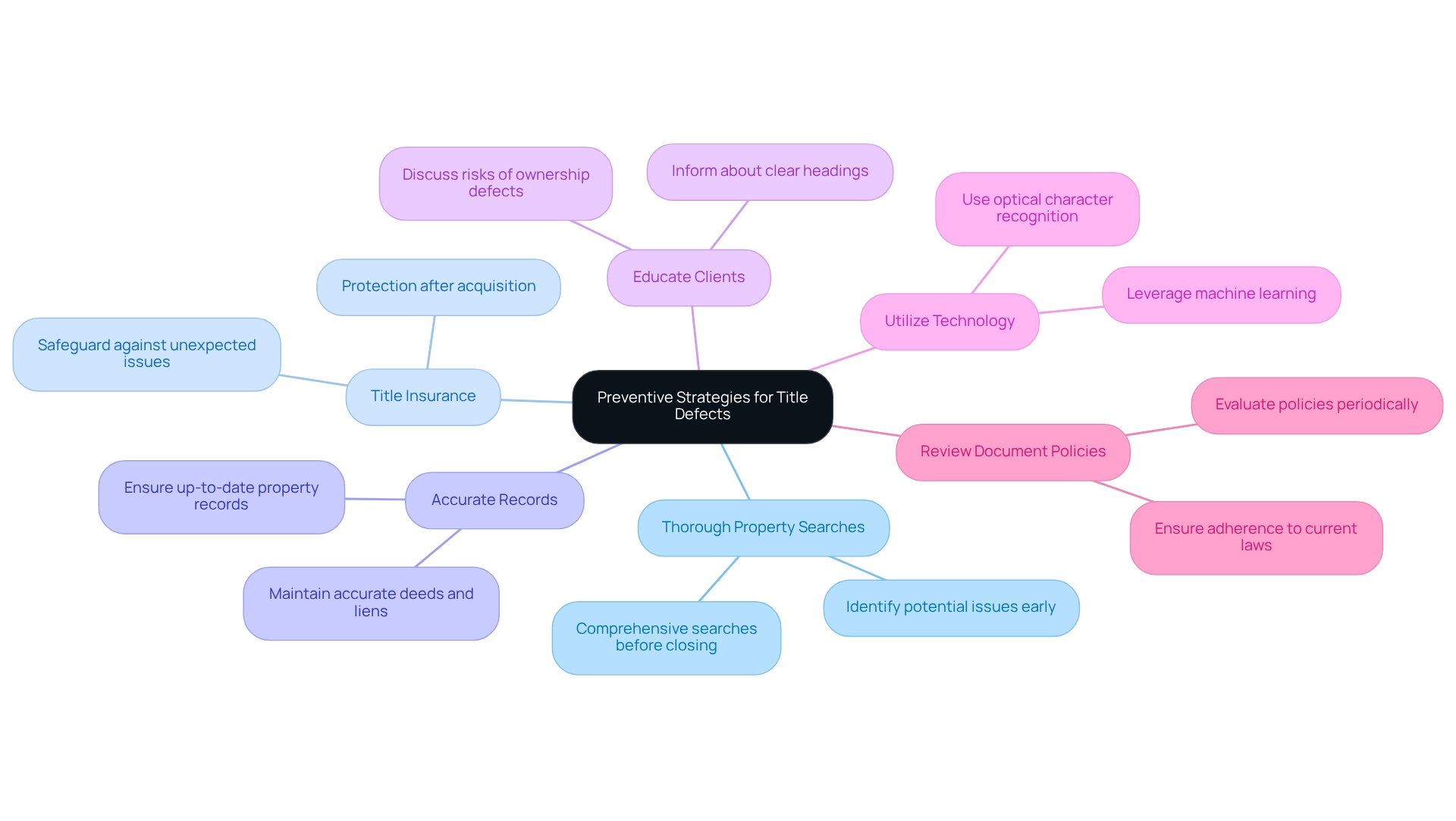Overview
To rectify a title defect, real estate professionals must adhere to a structured process that encompasses:
- Conducting a thorough title investigation
- Pinpointing the specific issue
- Gathering the requisite documentation
- Enlisting legal assistance, if necessary
This article delineates these essential steps and underscores the critical importance of consulting experts and leveraging advanced technology to streamline the resolution process, thereby preventing future title defects.
Introduction
In the intricate realm of real estate, title defects present formidable challenges that jeopardize the seamless transfer of property ownership. These legal complications—spanning liens, encumbrances, and inaccuracies in public records—can complicate transactions and impose financial liabilities on both buyers and sellers.
Grasping the essence of these defects is imperative for anyone engaged in real estate, as it establishes a foundation for effective resolution and prevention. With technological advancements and expert guidance, real estate professionals are now better prepared to navigate these complexities, ensuring that their transactions remain secure and efficient.
This article explores the various types of title defects, the necessary steps for resolution, and the preventive strategies that can protect future transactions.
Understand Title Defects in Real Estate
Title issues encompass any concerns that may affect the legal ownership of an asset, complicating or obstructing the transfer of ownership. Common types of title defects include the following:
- Liens: These are legal claims against the property due to unpaid debts, such as mortgages or taxes.
- Encumbrances: Restrictions on the asset, including easements or covenants that limit its utilization.
- Errors in Public Records: Mistakes in documentation, such as misspelled names or inaccurate asset descriptions.
- Unknown Heirs: Claims from individuals who may possess a legal right to the property through inheritance.
- Forgery or Fraud: Instances where documents have been falsified, impacting ownership validity.
Understanding how to is crucial for ensuring a smooth real estate transaction and safeguarding the interests of all parties involved. At Parse AI, we leverage our extensive industry expertise and advanced technologies, including automated property searches and AI-driven data analysis, to assist real estate professionals in effectively managing these challenges. By collaborating with industry specialists, we continuously enhance our solutions, enabling faster and more precise evaluations. Our platform not only identifies potential issues but also provides tools that simplify how to fix a title defect, ultimately leading to significant savings compared to traditional research methods.

Follow Steps to Resolve Title Defects
To resolve title defects, follow these steps:
- Conduct a Title Investigation: Initiate a thorough search of ownership to uncover any existing issues. This process entails reviewing public records and the chain of title to determine how to .
- Identify the Issue: Ascertain the specific nature of the problem, whether it’s a lien, encumbrance, or clerical error.
- Gather Documentation: Assemble all pertinent documents, including previous deeds, lien releases, and any correspondence related to the issue.
- Engage with Lienholders: If outstanding liens exist, reach out to the lienholders to negotiate payment or secure a release of lien.
- File Corrective Documents: For clerical errors, submit corrective deeds or affidavits to the appropriate government office to amend the public record.
- Consider legal action: In cases of disputes or complex matters, it may be necessary to learn how to fix a title defect by filing a quiet claim action to establish clear ownership.
- Secure Ownership Insurance: After resolving the issues, consider acquiring insurance to protect against future claims.

Consult Professionals for Expert Guidance
When addressing ownership issues, seeking advice from experts specializing in real estate legislation and ownership research is often advantageous. Consider the following key professionals:
- Real Estate Attorneys: They provide legal advice, assist in filing necessary documents, and represent you in court if needed.
- Property Companies: These firms conduct ownership searches and can help eliminate issues by offering ownership insurance and facilitating the resolution process.
- Surveyors: In cases of boundary disputes, hiring a professional surveyor clarifies property lines and resolves conflicts.
- Ownership Researchers: Engaging an ownership researcher ensures a thorough examination of the property's history, identifying potential issues that may not be immediately apparent.
Furthermore, utilizing from Parse AI can significantly enhance the effectiveness of document processing and research automation. With features such as interactive labeling and advanced OCR technology, Parse AI enables researchers to swiftly extract essential information from unstructured documents, ensuring a more precise and comprehensive examination. By merging professional advice with cutting-edge technology, real estate professionals can guarantee they are taking appropriate measures to address ownership issues efficiently and effectively.

Implement Preventive Strategies for Future Transactions
To prevent title defects in future transactions, it is essential to consider the following strategies:
- Conduct Thorough Property Searches: Always perform comprehensive property searches before closing any real estate transaction to identify potential issues early.
- Purchase Title Insurance: Title insurance can safeguard against unexpected issues that may occur after the acquisition.
- Maintain Accurate Records: Ensure that all property records are accurate and up-to-date, including deeds, liens, and any agreements.
- Educate Clients: Inform clients about the significance of clear headings and the potential risks related to ownership defects.
- Utilize Technology: Leverage technology, such as and optical character recognition, to streamline the research process and reduce human error.
- Regularly Review Document Policies: Periodically evaluate document policies and procedures to ensure adherence to current laws and best practices.
By implementing these preventive strategies, real estate professionals can significantly reduce the likelihood of encountering issues that require knowing how to fix a title defect in their transactions.

Conclusion
Title defects in real estate present significant barriers to the seamless transfer of property ownership, encompassing a range of issues from liens and encumbrances to errors in public records. Understanding these defects is crucial for all parties involved in real estate transactions, as it lays the groundwork for effective resolution and prevention. By employing thorough title searches and leveraging advanced technologies, real estate professionals can proactively identify and address these challenges.
The resolution of title defects necessitates a systematic approach, including:
- Conducting detailed title searches
- Gathering pertinent documentation
- Potentially engaging legal assistance when necessary
Collaborating with experienced professionals such as real estate attorneys and title companies can further streamline this resolution process, ensuring that all defects are adequately managed and cleared.
To safeguard against future title defects, implementing preventive strategies is essential. This includes:
- Conducting comprehensive title searches prior to transactions
- Obtaining title insurance
- Educating clients on the risks associated with title issues
By maintaining accurate records and utilizing innovative technology, real estate practitioners can significantly mitigate the risk of encountering title defects, fostering secure and efficient transactions.
In conclusion, navigating the complexities of title defects requires a proactive and informed approach. By understanding the nature of these defects, following a structured resolution process, and adopting preventive measures, real estate professionals can enhance the integrity of their transactions, ultimately protecting their clients’ interests and ensuring a smoother path to property ownership.
Frequently Asked Questions
What are title defects in real estate?
Title defects are concerns that may affect the legal ownership of a property, complicating or obstructing the transfer of ownership.
What are common types of title defects?
Common types of title defects include liens, encumbrances, errors in public records, unknown heirs, and instances of forgery or fraud.
What are liens in the context of title defects?
Liens are legal claims against a property due to unpaid debts, such as mortgages or taxes.
What are encumbrances?
Encumbrances are restrictions on a property, including easements or covenants that limit its utilization.
How can errors in public records affect property ownership?
Errors in public records can lead to issues such as misspelled names or inaccurate asset descriptions, which may complicate ownership claims.
What are unknown heirs?
Unknown heirs are individuals who may have a legal right to the property through inheritance, potentially affecting the transfer of ownership.
How does forgery or fraud impact real estate transactions?
Forgery or fraud involves falsified documents that can undermine the validity of ownership and create legal disputes.
Why is it important to fix title defects?
Fixing title defects is crucial for ensuring a smooth real estate transaction and safeguarding the interests of all parties involved.
How does Parse AI assist with title defects?
Parse AI leverages industry expertise and advanced technologies, including automated property searches and AI-driven data analysis, to help real estate professionals manage title defects effectively.
What advantages does Parse AI offer in managing title defects?
Parse AI offers faster and more precise evaluations, identifies potential issues, and provides tools to simplify the process of fixing title defects, leading to significant savings compared to traditional research methods.




